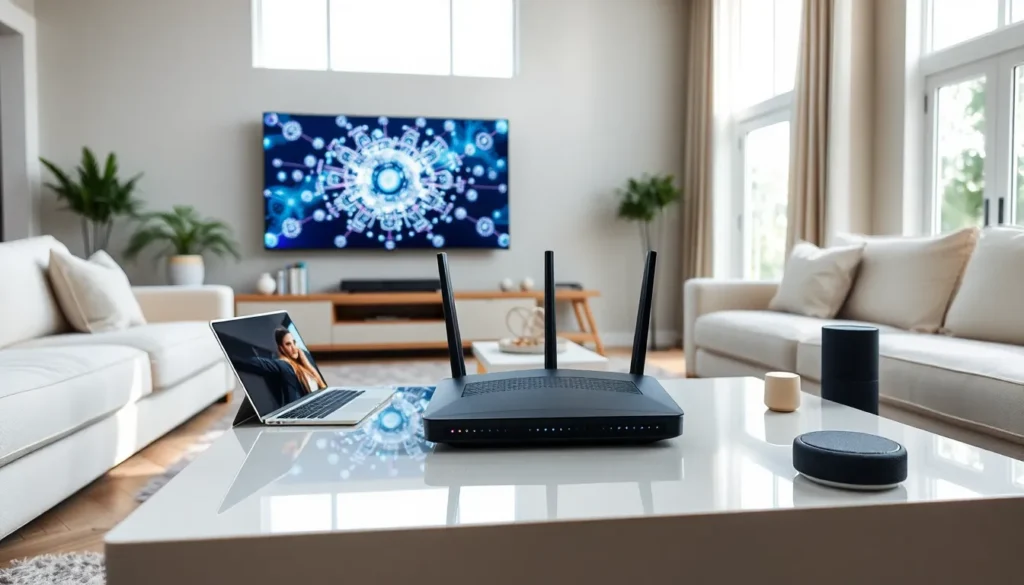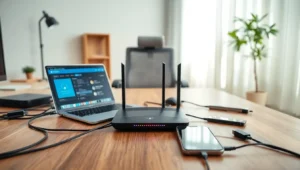Imagine a world where every room in your home is a tech wonderland, where streaming movies doesn’t freeze and video calls don’t drop. Welcome to the paradise of a well-planned home networking setup. It’s time to untangle the jargon and geeky bits about networking. Whether you’re connecting devices for the first time or upgrading an old setup, this guide will walk you through everything in a funny yet knowledgeable way. Let’s jump into the digital sea and see what treasures await.
Table of Contents
ToggleUnderstanding Home Networking

Home networking is all about connecting various devices within your home to share resources and access the internet. At its core, it’s a system that allows computers, smartphones, smart TVs, and even appliances to communicate with one another. Think of it like a digital family reunion, where everyone gets a chance to share their toys without throwing a tantrum. This structure not only facilitates internet access but also enables sharing files, printers, and media, all while sipping your coffee on the couch.
Understanding the components is easy. Usually, a home network consists of a modem and a router. The modem is the gateway to the internet, receiving and sending data to and from your Internet Service Provider (ISP). Meanwhile, the router manages the traffic within your home, deciding which device gets what data. This ensures that streaming isn’t interrupted because someone decided to scroll through social media.
In simpler terms, a home network is like a bustling highway where data packets travel to and fro, guided by traffic lights (your router) to avoid crashes.
All of this might sound technical, but with a little knowledge, anyone can create a robust home network that serves their needs.
Types of Home Networks
Home networks can be categorized into several types based on the connection methods used: wired, wireless, or a combination of both. Each type has its pros and cons, making it essential to consider specific needs.
Wired Networks
A wired network uses Ethernet cables to connect devices directly to the router. It’s reliable, with stable connections and higher speeds. Think of it as the old-school landline phone, solid and dependable. But, it does require cables to be run throughout the house, which might take some creative decorating skills to hide.
Wireless Networks
Conversely, wireless networks use Wi-Fi technology. These offer flexibility and are super convenient, perfect for mobile devices. Picture your smartphone dancing around the house while streaming a podcast. Wireless networks are easy to set up but can suffer from interference: think of it as trying to have a conversation in a crowded café, sometimes you just can’t hear each other.
Hybrid Networks
Finally, hybrid networks combine wired and wireless options, giving the best of both worlds. You can hardwire your most important devices like gaming consoles or Desktop PCs for a consistent connection while allowing laptops and smartphones the freedom of Wi-Fi. The versatility of this setup creates a tailored experience fitting for most households.
Essential Equipment for Home Networking
To set up a solid home network, certain essential equipment is needed. Without these fundamental tools, expect hiccups and frustrations along the way.
- Modem: This device connects your home to the internet. Most ISPs provide one: but, purchasing your own can offer better performance.
- Router: A wireless router is essential for distributing internet connections to various devices. Features to look for include dual-band capabilities and MU-MIMO technology for better performance.
- Ethernet Cables: Never underestimate the power of a simple cable. For wired connections, get high-quality Ethernet cables to ensure speed and reliability.
- Network Switch: If there are multiple wired devices, a network switch expands the number of ports available, allowing several devices to connect through a single Ethernet cable from the router.
- Wi-Fi Extender: To eliminate dead zones in larger homes, consider adding a Wi-Fi extender. This device boosts the signal, ensuring coverage even in the farthest corners of your abode.
- Firewall: For security, a hardware firewall provides another layer of protection against unwanted access. Think of it as a bouncer at an exclusive party, only the invited get in.
Equipped with these tools, anyone can build a home network that’s not only efficient but also secure.
Step-By-Step Guide to Setting Up Your Network
Setting up a home network might feel overwhelming, but it can be a straightforward process if approached methodically. Follow these steps for hassle-free setup:
1. Choose Your Location
Find the optimal place for your modem and router, ideally in a central location in your home, away from walls and obstructions to maximize Wi-Fi coverage.
2. Connect the Modem
Start by connecting the modem to the wall jack provided by your ISP using the coaxial cable or DSL line. Power it up and wait for a stable connection.
3. Connect the Router
Next, plug the router into the modem using an Ethernet cable. This step establishes a link between the internet and your home network.
4. Power Up Devices
Turn on the router and give it a few moments to boot up. You’ll see lights indicating connectivity and operation. If everything is working correctly, move on to connecting your devices.
5. Configure the Router
Access the router’s settings via a web browser using the IP address found in the manual. Here, you’ll set the network name (SSID) and password, making them easy to remember but hard to guess.
6. Connect Devices
Once everything is set up, connect your devices to the new network using the SSID and password. Wired devices should be connected directly using Ethernet cables.
7. Test Your Connection
Finally, test the connection speed using an online speed test. This ensures everything is functioning as it should. If not, revisit the setup process to see if any components require adjustment.
Securing Your Home Network
After establishing a robust network, protecting it becomes paramount. A few precautionary steps can go a long way in safeguarding your digital domain:
- Change Default Passwords: Most routers come with default usernames and passwords. Changing these immediately can prevent unauthorized access.
- Enable WPA3 Encryption: Ensure that your network is encrypted using WPA3 to add a layer of security against potential intruders.
- Turn Off WPS: Wi-Fi Protected Setup (WPS) can create vulnerabilities. Disabling this feature prevents unauthorized connections.
- Guest Network: Set up a guest network for visitors. This isolates their devices from yours, reducing the risk of potential breaches.
- Keep Firmware Updated: Regularly updating your router’s firmware helps patch security vulnerabilities and ensures optimal performance.
By following these security measures, any homeowner can build a fortress around their networking setup.
Troubleshooting Common Networking Issues
Even the best home networks can face hiccups. Here are some common issues and how to remedy them:
1. Weak Wi-Fi Signal
If the signal is weak in certain areas, try repositioning the router or adding Wi-Fi extenders to improve coverage. Sometimes, simple adjustments can make a world of difference.
2. Slow Internet Speeds
If the internet seems slower than usual, check how many devices are competing for bandwidth. Limit the number of active devices or consider upgrading your internet plan if required.
3. Connection Drops
Experiencing frequent disconnections? Restart the router, this can help relieve temporary congestion. If issues persist, consider checking your ISP status or connection stability.
4. Device Not Connecting
If a specific device can’t connect, forget the network on that device and re-enter the password. Ensure you’re using the correct SSID as well.
By understanding these troubleshooting steps, anyone can tackle network issues with confidence, turning frustrations into quick fixes.
Future of Home Networking
As technology advances, so does home networking. The future promises innovations that aim to enhance user experience and connectivity:
- Wi-Fi 6 (802.11ax): The latest standard improves speeds, capacity, and efficiency. This means faster streaming, gaming, and browsing without interruptions.
- Mesh Networks: These systems use multiple nodes placed throughout the home to provide seamless coverage, eliminating dead zones and ensuring a stronger connection everywhere.
- Smart Home Integration: Future networks will likely integrate even more seamlessly with smart home devices, making control super convenient through advanced automation systems.
- Increased Focus on Security: As cyber threats evolve, expect home networks to incorporate more robust security measures, protecting personal data and devices on a whole new level.
The future is bright for home networking, with exciting advancements poised to make connectivity easier and more efficient.
Embracing these innovations will enable users to enhance their everyday experiences with technology, enabling smoother operations across all devices.





